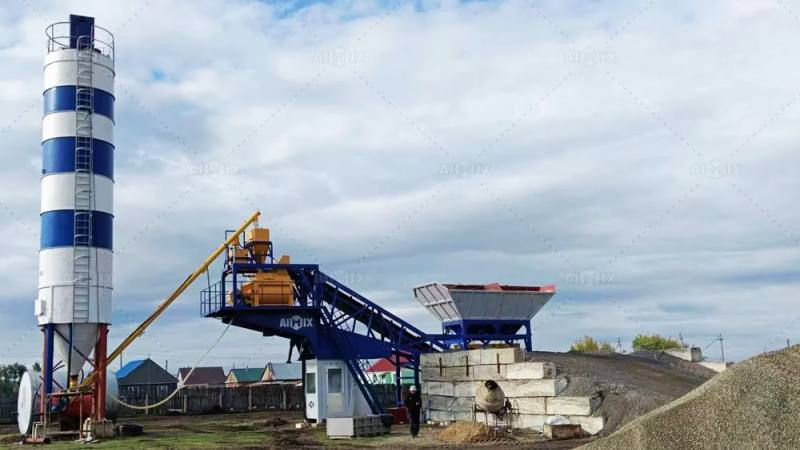Low-Emission Mobile Concrete Plants: Complying with Environmental Regulations
- aimixglobal5
- Oct 5
- 3 min read
The construction industry is under increasing pressure to reduce environmental impact while maintaining productivity and quality. One of the critical areas of focus is concrete production, which can generate significant dust, noise, and carbon emissions. To address these challenges, low-emission mobile concrete plants have emerged as an ideal solution. For contractors and businesses operating in regions like Southeast Asia, including mobile batching plant Indonesia projects, adopting these environmentally friendly technologies is essential for regulatory compliance and sustainable operations.

1. Understanding Low-Emission Mobile Concrete Plants
Low-emission mobile concrete plants are designed to minimize pollutants while maintaining efficient concrete production. These plants combine advanced technology, energy-efficient systems, and optimized material handling to reduce the release of dust, particulate matter, and greenhouse gases. Unlike traditional stationary plants, mobile units offer flexibility and can be deployed on temporary construction sites or urban projects with stringent environmental regulations.
In Indonesia, where infrastructure projects are booming, mobile batching plant Indonesia units equipped with low-emission technology are increasingly preferred for highway, airport, and residential developments.
2. Air Quality and Dust Control
One of the primary environmental concerns in concrete production is dust, generated from cement, aggregates, and fly ash handling. Low-emission mobile concrete plants incorporate dust suppression systems, such as:
Baghouse filters and cyclone separators to capture fine particles.
Enclosed conveyors and storage silos to reduce dust dispersion.
Water spray systems at aggregate and cement handling points.
For a mobile batching plant Indonesia, dust control is particularly important due to dense urban areas and residential proximity. Proper dust management ensures compliance with local environmental regulations and protects worker health.
3. Noise Reduction
Concrete batching operations produce noise from mixers, conveyors, and aggregate handling equipment. Excessive noise can affect nearby communities and construction site personnel. Low-emission mobile concrete plants integrate noise-reducing technologies such as:
Soundproofed mixer enclosures
Vibration-damping foundations
Low-noise electric or hydraulic motors
In Indonesia, urban projects often face strict noise restrictions. A mobile batching plant Indonesia with noise control measures not only ensures regulatory compliance but also promotes better relationships with local communities.
4. Energy Efficiency and Carbon Emissions
Energy consumption and CO₂ emissions are key factors in environmental compliance. Low-emission mobile concrete plants use energy-efficient motors, variable frequency drives (VFDs), and optimized batching systems to minimize fuel and electricity usage.
Electric or hybrid-powered mobile units further reduce emissions, making them ideal for areas with strict carbon regulations. For contractors investing in a mobile batching plant Indonesia, energy-efficient designs reduce operating costs while supporting sustainability goals.

5. Water Management and Recycling
Concrete production requires substantial water, which, if not managed properly, can contaminate local water sources. Low-emission mobile concrete plants are equipped with water recycling and treatment systems that:
Capture wash water from mixers and trucks
Filter and remove solids before reuse
Reduce freshwater consumption and wastewater discharge
In Indonesia, water management is crucial for complying with environmental regulations and conserving local resources. A mobile batching plant Indonesia with integrated water recycling ensures efficient water usage and regulatory compliance.
6. Sustainable Material Usage
The use of eco-friendly materials further reduces the environmental impact of concrete production. Low-emission mobile concrete plants can handle:
Recycled aggregates from demolition waste
Supplementary cementitious materials (SCMs) like fly ash or slag
Low-carbon cement blends
By integrating sustainable materials, contractors can reduce greenhouse gas emissions associated with concrete production and meet local sustainability standards. For mobile batching plant Indonesia projects, this flexibility is essential for both cost-effectiveness and regulatory compliance.
7. Compliance with Local and International Standards
Environmental regulations vary by country and region. In Indonesia, contractors must adhere to guidelines on dust, noise, water discharge, and CO₂ emissions. Low-emission mobile concrete plants are designed to meet these requirements, often featuring:
Emission control certifications
Noise compliance labels
Integrated water treatment and recycling systems
Selecting a mobile batching plant Indonesia with verified compliance documentation reduces the risk of fines, project delays, and reputational damage.
8. Operational Best Practices
Even the most advanced low-emission mobile concrete plant requires proper operational practices to maximize environmental benefits:
Schedule batching during off-peak hours to minimize noise impact
Maintain dust filters, motors, and water systems regularly
Train operators on eco-friendly batching procedures
Monitor emissions and resource usage continuously
Following these best practices ensures a mobile batching plant Indonesia operates efficiently while minimizing environmental impact.

Conclusion
Low-emission mobile concrete plants represent the future of sustainable construction. By integrating dust suppression, noise reduction, energy efficiency, water recycling, and sustainable material handling, these plants help contractors comply with environmental regulations while maintaining productivity.
For construction projects in Indonesia, investing in a mobile batching plant Indonesia with low-emission technology is increasingly essential. It reduces operational costs, protects worker health, conserves resources, and enhances corporate sustainability credentials. As environmental regulations tighten and green construction becomes a priority, low-emission mobile concrete plants provide a competitive advantage for contractors committed to responsible and efficient construction practices.







Comments